HI6005 Management: Ford, Taylorism & Globalization Analysis
VerifiedAdded on 2023/06/13
|8
|1462
|279
Report
AI Summary
This report analyzes Ford and Taylorism principles in the context of management and organizational behavior, applying these theories to real-world scenarios such as Computershare Limited. It further discusses Pankaj Ghemawat's perspective on globalization, contrasting it with prevailing views and highlighting the importance of understanding cross-border differences. The report concludes by emphasizing the practical implications of Ford and Taylorism for improving company performance and productivity, while also advocating for a nuanced approach to managing global similarities and differences as suggested by Ghemawat. This student contributed assignment is available on Desklib, where you can find similar resources and study tools.
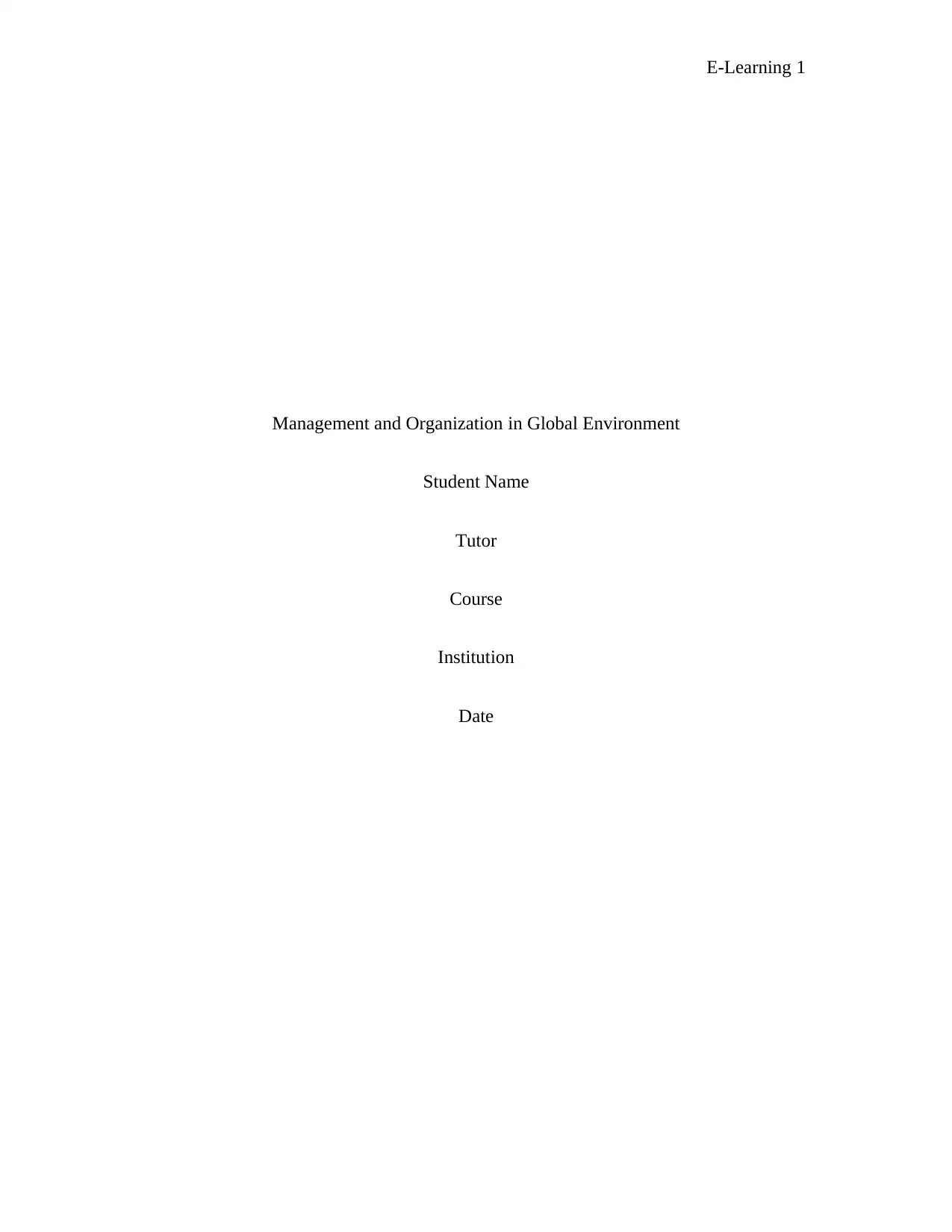
E-Learning 1
Management and Organization in Global Environment
Student Name
Tutor
Course
Institution
Date
Management and Organization in Global Environment
Student Name
Tutor
Course
Institution
Date
Paraphrase This Document
Need a fresh take? Get an instant paraphrase of this document with our AI Paraphraser
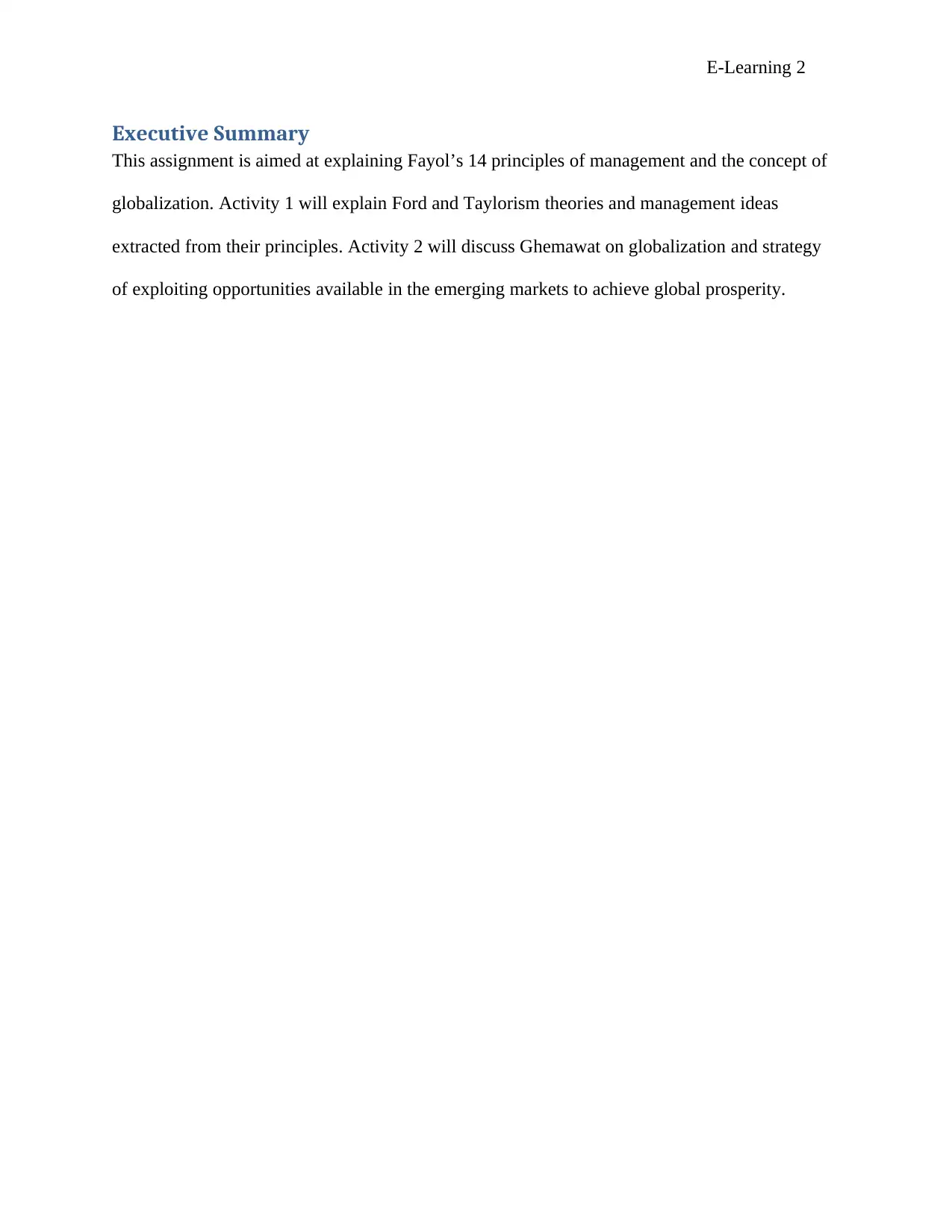
E-Learning 2
Executive Summary
This assignment is aimed at explaining Fayol’s 14 principles of management and the concept of
globalization. Activity 1 will explain Ford and Taylorism theories and management ideas
extracted from their principles. Activity 2 will discuss Ghemawat on globalization and strategy
of exploiting opportunities available in the emerging markets to achieve global prosperity.
Executive Summary
This assignment is aimed at explaining Fayol’s 14 principles of management and the concept of
globalization. Activity 1 will explain Ford and Taylorism theories and management ideas
extracted from their principles. Activity 2 will discuss Ghemawat on globalization and strategy
of exploiting opportunities available in the emerging markets to achieve global prosperity.
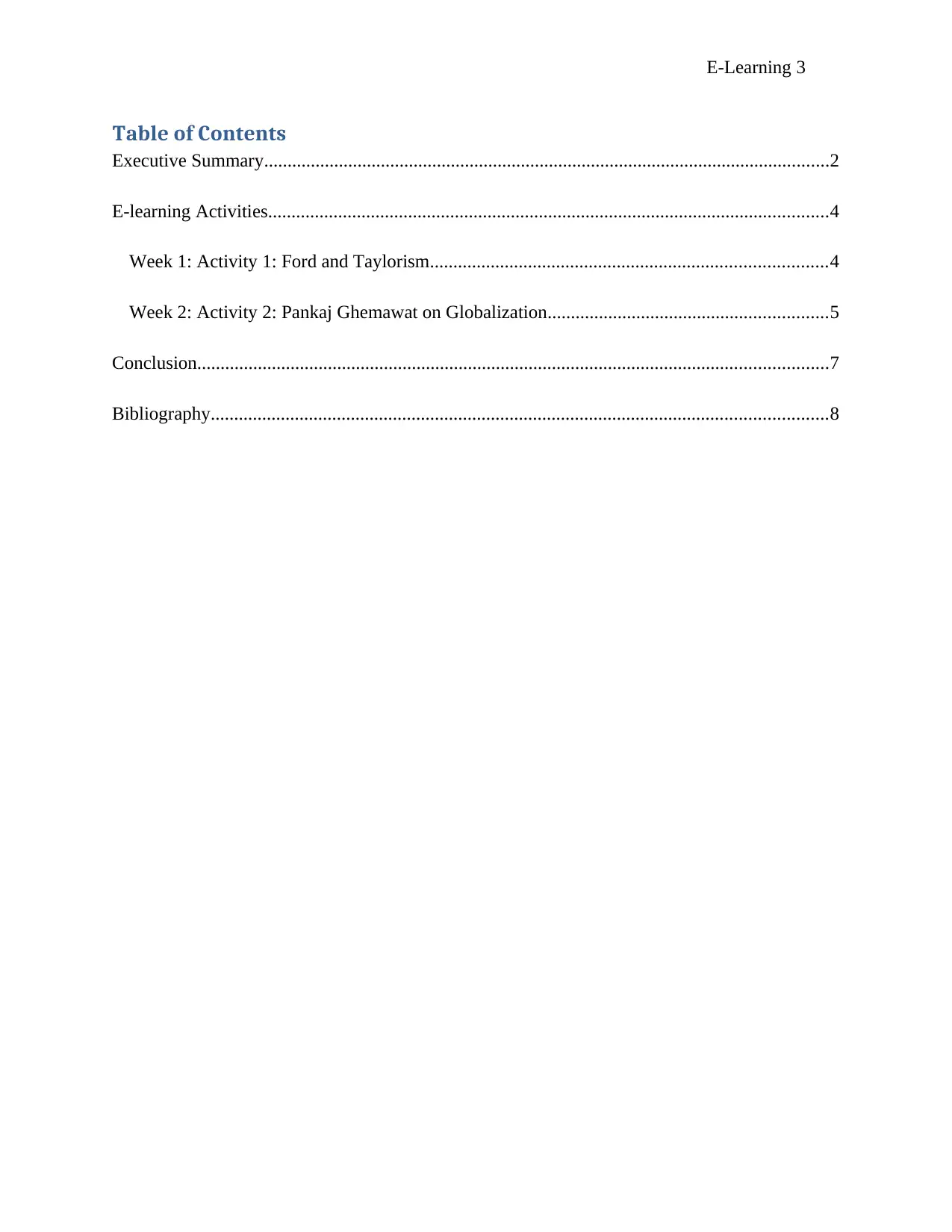
E-Learning 3
Table of Contents
Executive Summary.........................................................................................................................2
E-learning Activities........................................................................................................................4
Week 1: Activity 1: Ford and Taylorism.....................................................................................4
Week 2: Activity 2: Pankaj Ghemawat on Globalization............................................................5
Conclusion.......................................................................................................................................7
Bibliography....................................................................................................................................8
Table of Contents
Executive Summary.........................................................................................................................2
E-learning Activities........................................................................................................................4
Week 1: Activity 1: Ford and Taylorism.....................................................................................4
Week 2: Activity 2: Pankaj Ghemawat on Globalization............................................................5
Conclusion.......................................................................................................................................7
Bibliography....................................................................................................................................8
⊘ This is a preview!⊘
Do you want full access?
Subscribe today to unlock all pages.

Trusted by 1+ million students worldwide
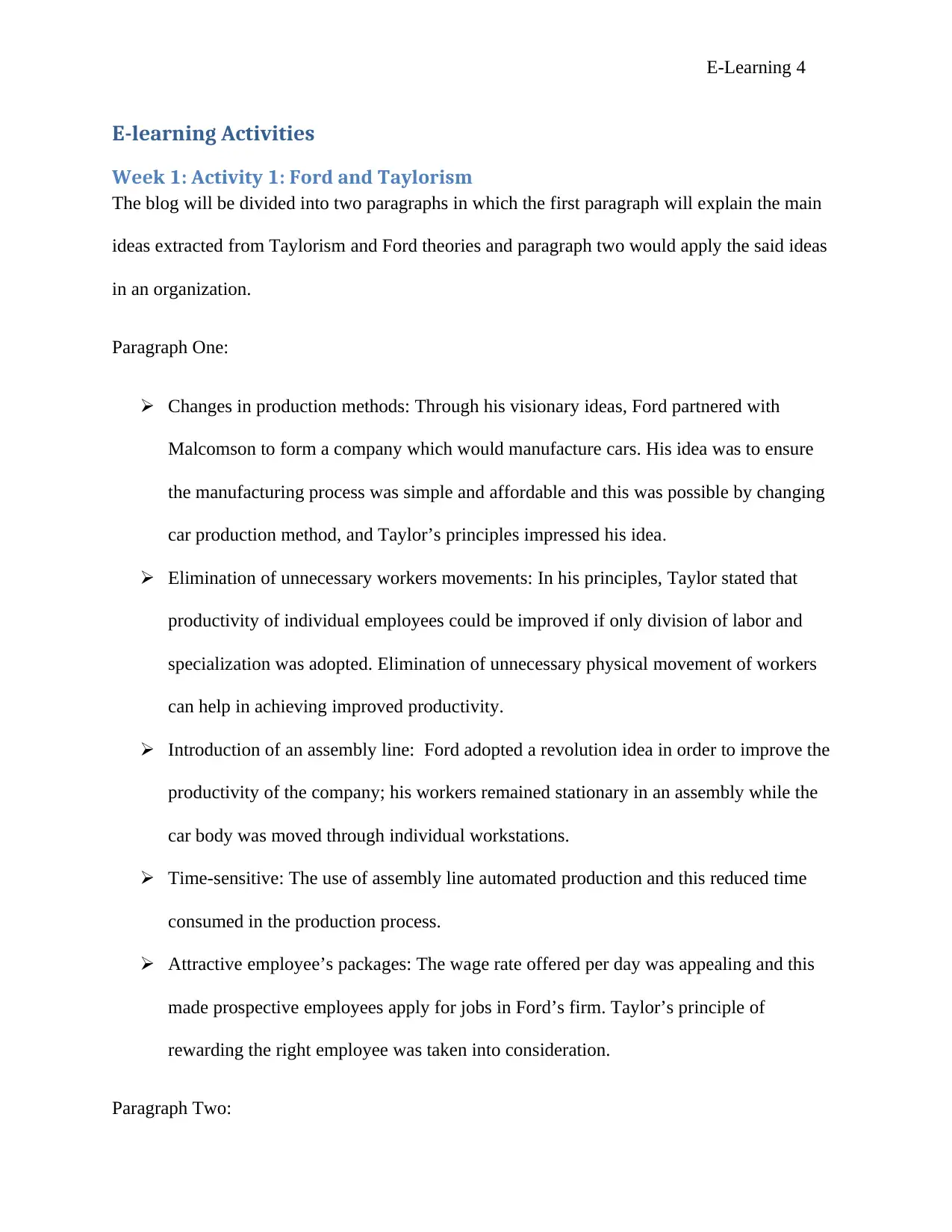
E-Learning 4
E-learning Activities
Week 1: Activity 1: Ford and Taylorism
The blog will be divided into two paragraphs in which the first paragraph will explain the main
ideas extracted from Taylorism and Ford theories and paragraph two would apply the said ideas
in an organization.
Paragraph One:
Changes in production methods: Through his visionary ideas, Ford partnered with
Malcomson to form a company which would manufacture cars. His idea was to ensure
the manufacturing process was simple and affordable and this was possible by changing
car production method, and Taylor’s principles impressed his idea.
Elimination of unnecessary workers movements: In his principles, Taylor stated that
productivity of individual employees could be improved if only division of labor and
specialization was adopted. Elimination of unnecessary physical movement of workers
can help in achieving improved productivity.
Introduction of an assembly line: Ford adopted a revolution idea in order to improve the
productivity of the company; his workers remained stationary in an assembly while the
car body was moved through individual workstations.
Time-sensitive: The use of assembly line automated production and this reduced time
consumed in the production process.
Attractive employee’s packages: The wage rate offered per day was appealing and this
made prospective employees apply for jobs in Ford’s firm. Taylor’s principle of
rewarding the right employee was taken into consideration.
Paragraph Two:
E-learning Activities
Week 1: Activity 1: Ford and Taylorism
The blog will be divided into two paragraphs in which the first paragraph will explain the main
ideas extracted from Taylorism and Ford theories and paragraph two would apply the said ideas
in an organization.
Paragraph One:
Changes in production methods: Through his visionary ideas, Ford partnered with
Malcomson to form a company which would manufacture cars. His idea was to ensure
the manufacturing process was simple and affordable and this was possible by changing
car production method, and Taylor’s principles impressed his idea.
Elimination of unnecessary workers movements: In his principles, Taylor stated that
productivity of individual employees could be improved if only division of labor and
specialization was adopted. Elimination of unnecessary physical movement of workers
can help in achieving improved productivity.
Introduction of an assembly line: Ford adopted a revolution idea in order to improve the
productivity of the company; his workers remained stationary in an assembly while the
car body was moved through individual workstations.
Time-sensitive: The use of assembly line automated production and this reduced time
consumed in the production process.
Attractive employee’s packages: The wage rate offered per day was appealing and this
made prospective employees apply for jobs in Ford’s firm. Taylor’s principle of
rewarding the right employee was taken into consideration.
Paragraph Two:
Paraphrase This Document
Need a fresh take? Get an instant paraphrase of this document with our AI Paraphraser
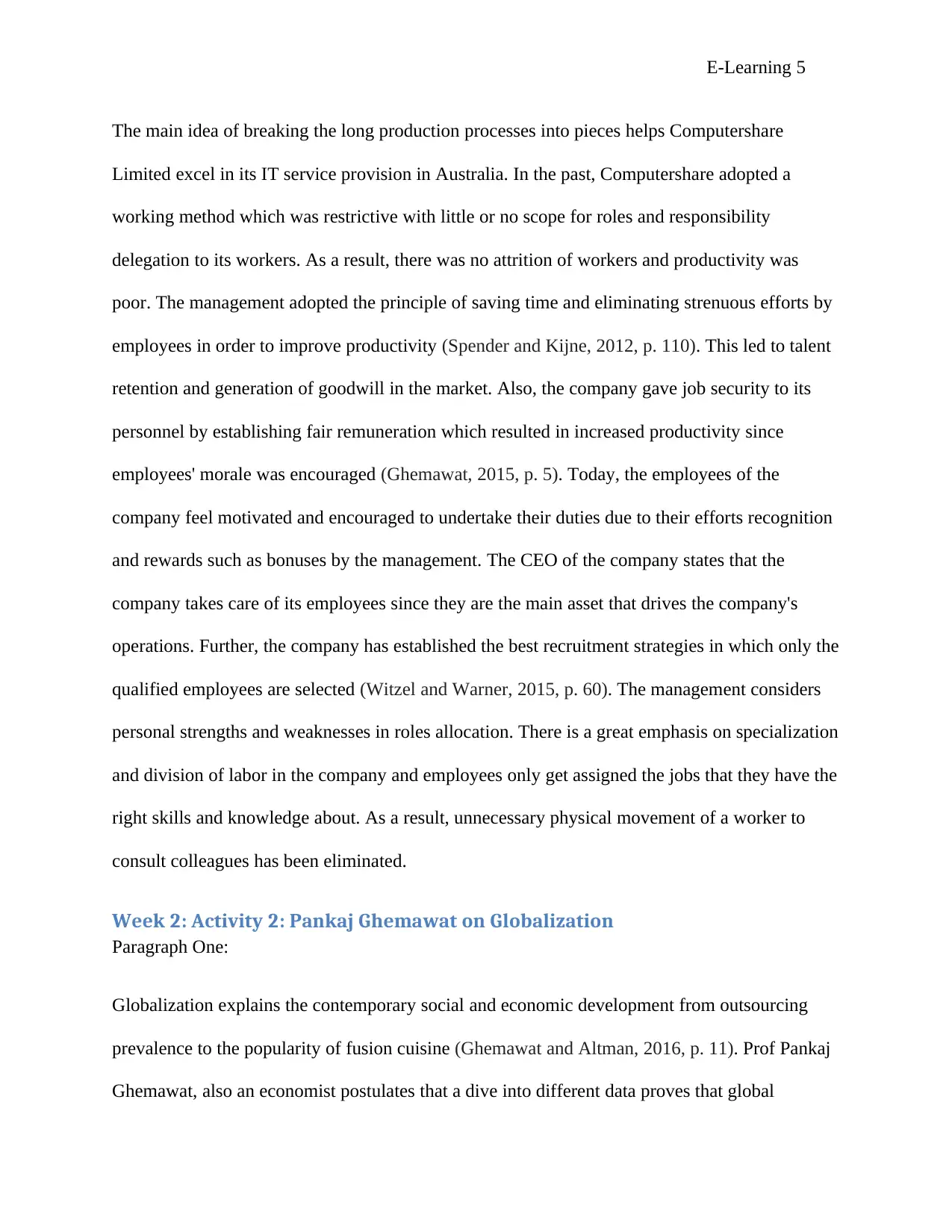
E-Learning 5
The main idea of breaking the long production processes into pieces helps Computershare
Limited excel in its IT service provision in Australia. In the past, Computershare adopted a
working method which was restrictive with little or no scope for roles and responsibility
delegation to its workers. As a result, there was no attrition of workers and productivity was
poor. The management adopted the principle of saving time and eliminating strenuous efforts by
employees in order to improve productivity (Spender and Kijne, 2012, p. 110). This led to talent
retention and generation of goodwill in the market. Also, the company gave job security to its
personnel by establishing fair remuneration which resulted in increased productivity since
employees' morale was encouraged (Ghemawat, 2015, p. 5). Today, the employees of the
company feel motivated and encouraged to undertake their duties due to their efforts recognition
and rewards such as bonuses by the management. The CEO of the company states that the
company takes care of its employees since they are the main asset that drives the company's
operations. Further, the company has established the best recruitment strategies in which only the
qualified employees are selected (Witzel and Warner, 2015, p. 60). The management considers
personal strengths and weaknesses in roles allocation. There is a great emphasis on specialization
and division of labor in the company and employees only get assigned the jobs that they have the
right skills and knowledge about. As a result, unnecessary physical movement of a worker to
consult colleagues has been eliminated.
Week 2: Activity 2: Pankaj Ghemawat on Globalization
Paragraph One:
Globalization explains the contemporary social and economic development from outsourcing
prevalence to the popularity of fusion cuisine (Ghemawat and Altman, 2016, p. 11). Prof Pankaj
Ghemawat, also an economist postulates that a dive into different data proves that global
The main idea of breaking the long production processes into pieces helps Computershare
Limited excel in its IT service provision in Australia. In the past, Computershare adopted a
working method which was restrictive with little or no scope for roles and responsibility
delegation to its workers. As a result, there was no attrition of workers and productivity was
poor. The management adopted the principle of saving time and eliminating strenuous efforts by
employees in order to improve productivity (Spender and Kijne, 2012, p. 110). This led to talent
retention and generation of goodwill in the market. Also, the company gave job security to its
personnel by establishing fair remuneration which resulted in increased productivity since
employees' morale was encouraged (Ghemawat, 2015, p. 5). Today, the employees of the
company feel motivated and encouraged to undertake their duties due to their efforts recognition
and rewards such as bonuses by the management. The CEO of the company states that the
company takes care of its employees since they are the main asset that drives the company's
operations. Further, the company has established the best recruitment strategies in which only the
qualified employees are selected (Witzel and Warner, 2015, p. 60). The management considers
personal strengths and weaknesses in roles allocation. There is a great emphasis on specialization
and division of labor in the company and employees only get assigned the jobs that they have the
right skills and knowledge about. As a result, unnecessary physical movement of a worker to
consult colleagues has been eliminated.
Week 2: Activity 2: Pankaj Ghemawat on Globalization
Paragraph One:
Globalization explains the contemporary social and economic development from outsourcing
prevalence to the popularity of fusion cuisine (Ghemawat and Altman, 2016, p. 11). Prof Pankaj
Ghemawat, also an economist postulates that a dive into different data proves that global
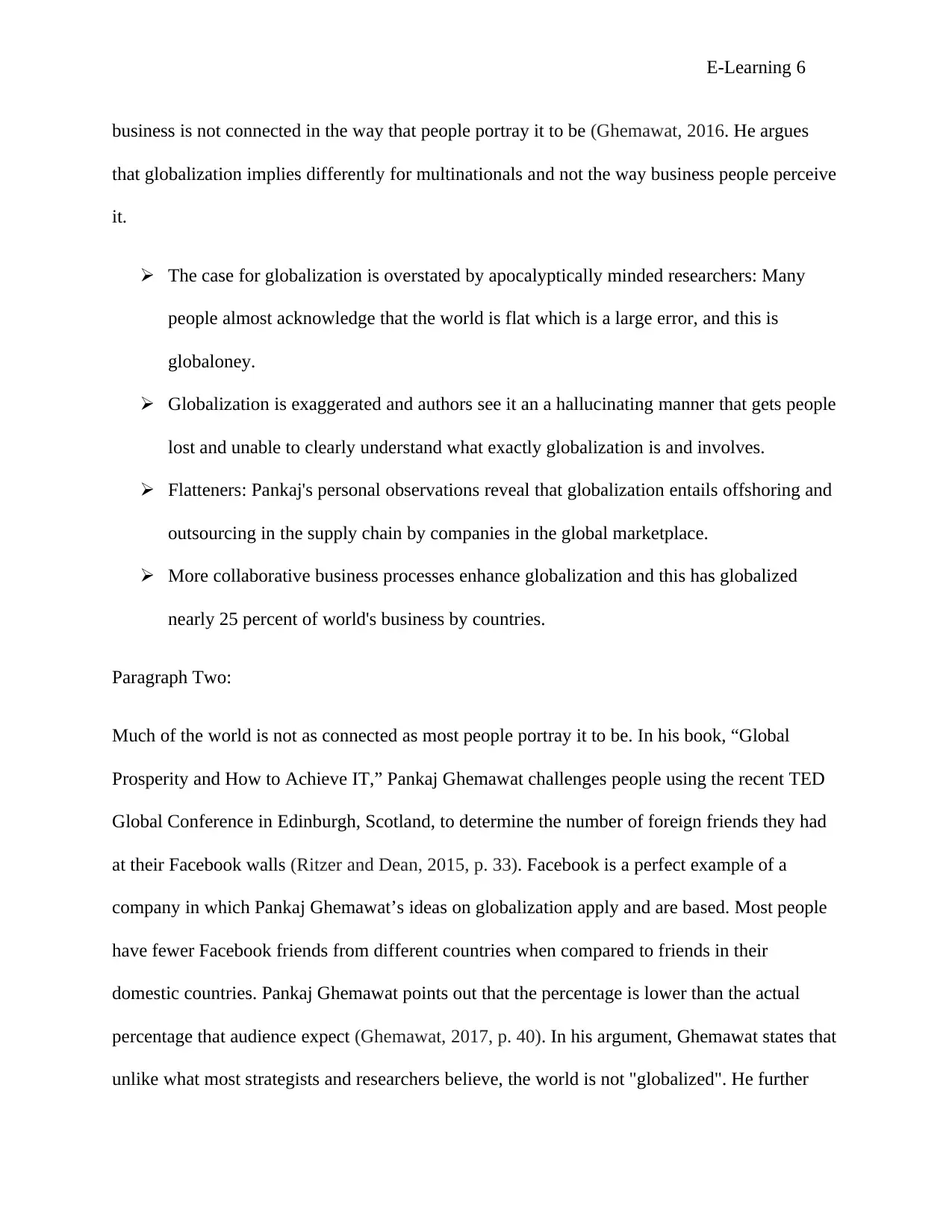
E-Learning 6
business is not connected in the way that people portray it to be (Ghemawat, 2016. He argues
that globalization implies differently for multinationals and not the way business people perceive
it.
The case for globalization is overstated by apocalyptically minded researchers: Many
people almost acknowledge that the world is flat which is a large error, and this is
globaloney.
Globalization is exaggerated and authors see it an a hallucinating manner that gets people
lost and unable to clearly understand what exactly globalization is and involves.
Flatteners: Pankaj's personal observations reveal that globalization entails offshoring and
outsourcing in the supply chain by companies in the global marketplace.
More collaborative business processes enhance globalization and this has globalized
nearly 25 percent of world's business by countries.
Paragraph Two:
Much of the world is not as connected as most people portray it to be. In his book, “Global
Prosperity and How to Achieve IT,” Pankaj Ghemawat challenges people using the recent TED
Global Conference in Edinburgh, Scotland, to determine the number of foreign friends they had
at their Facebook walls (Ritzer and Dean, 2015, p. 33). Facebook is a perfect example of a
company in which Pankaj Ghemawat’s ideas on globalization apply and are based. Most people
have fewer Facebook friends from different countries when compared to friends in their
domestic countries. Pankaj Ghemawat points out that the percentage is lower than the actual
percentage that audience expect (Ghemawat, 2017, p. 40). In his argument, Ghemawat states that
unlike what most strategists and researchers believe, the world is not "globalized". He further
business is not connected in the way that people portray it to be (Ghemawat, 2016. He argues
that globalization implies differently for multinationals and not the way business people perceive
it.
The case for globalization is overstated by apocalyptically minded researchers: Many
people almost acknowledge that the world is flat which is a large error, and this is
globaloney.
Globalization is exaggerated and authors see it an a hallucinating manner that gets people
lost and unable to clearly understand what exactly globalization is and involves.
Flatteners: Pankaj's personal observations reveal that globalization entails offshoring and
outsourcing in the supply chain by companies in the global marketplace.
More collaborative business processes enhance globalization and this has globalized
nearly 25 percent of world's business by countries.
Paragraph Two:
Much of the world is not as connected as most people portray it to be. In his book, “Global
Prosperity and How to Achieve IT,” Pankaj Ghemawat challenges people using the recent TED
Global Conference in Edinburgh, Scotland, to determine the number of foreign friends they had
at their Facebook walls (Ritzer and Dean, 2015, p. 33). Facebook is a perfect example of a
company in which Pankaj Ghemawat’s ideas on globalization apply and are based. Most people
have fewer Facebook friends from different countries when compared to friends in their
domestic countries. Pankaj Ghemawat points out that the percentage is lower than the actual
percentage that audience expect (Ghemawat, 2017, p. 40). In his argument, Ghemawat states that
unlike what most strategists and researchers believe, the world is not "globalized". He further
⊘ This is a preview!⊘
Do you want full access?
Subscribe today to unlock all pages.

Trusted by 1+ million students worldwide
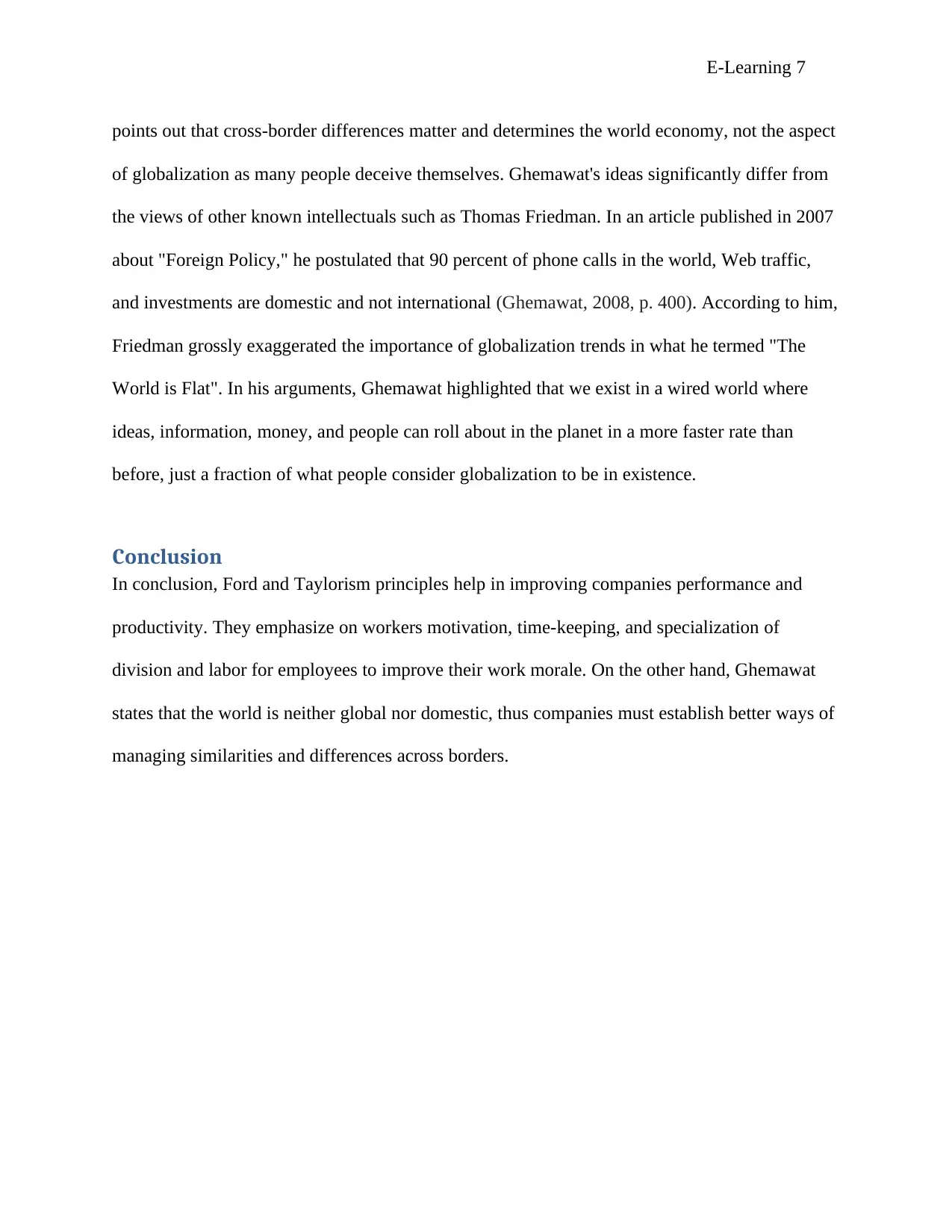
E-Learning 7
points out that cross-border differences matter and determines the world economy, not the aspect
of globalization as many people deceive themselves. Ghemawat's ideas significantly differ from
the views of other known intellectuals such as Thomas Friedman. In an article published in 2007
about "Foreign Policy," he postulated that 90 percent of phone calls in the world, Web traffic,
and investments are domestic and not international (Ghemawat, 2008, p. 400). According to him,
Friedman grossly exaggerated the importance of globalization trends in what he termed "The
World is Flat". In his arguments, Ghemawat highlighted that we exist in a wired world where
ideas, information, money, and people can roll about in the planet in a more faster rate than
before, just a fraction of what people consider globalization to be in existence.
Conclusion
In conclusion, Ford and Taylorism principles help in improving companies performance and
productivity. They emphasize on workers motivation, time-keeping, and specialization of
division and labor for employees to improve their work morale. On the other hand, Ghemawat
states that the world is neither global nor domestic, thus companies must establish better ways of
managing similarities and differences across borders.
points out that cross-border differences matter and determines the world economy, not the aspect
of globalization as many people deceive themselves. Ghemawat's ideas significantly differ from
the views of other known intellectuals such as Thomas Friedman. In an article published in 2007
about "Foreign Policy," he postulated that 90 percent of phone calls in the world, Web traffic,
and investments are domestic and not international (Ghemawat, 2008, p. 400). According to him,
Friedman grossly exaggerated the importance of globalization trends in what he termed "The
World is Flat". In his arguments, Ghemawat highlighted that we exist in a wired world where
ideas, information, money, and people can roll about in the planet in a more faster rate than
before, just a fraction of what people consider globalization to be in existence.
Conclusion
In conclusion, Ford and Taylorism principles help in improving companies performance and
productivity. They emphasize on workers motivation, time-keeping, and specialization of
division and labor for employees to improve their work morale. On the other hand, Ghemawat
states that the world is neither global nor domestic, thus companies must establish better ways of
managing similarities and differences across borders.
Paraphrase This Document
Need a fresh take? Get an instant paraphrase of this document with our AI Paraphraser
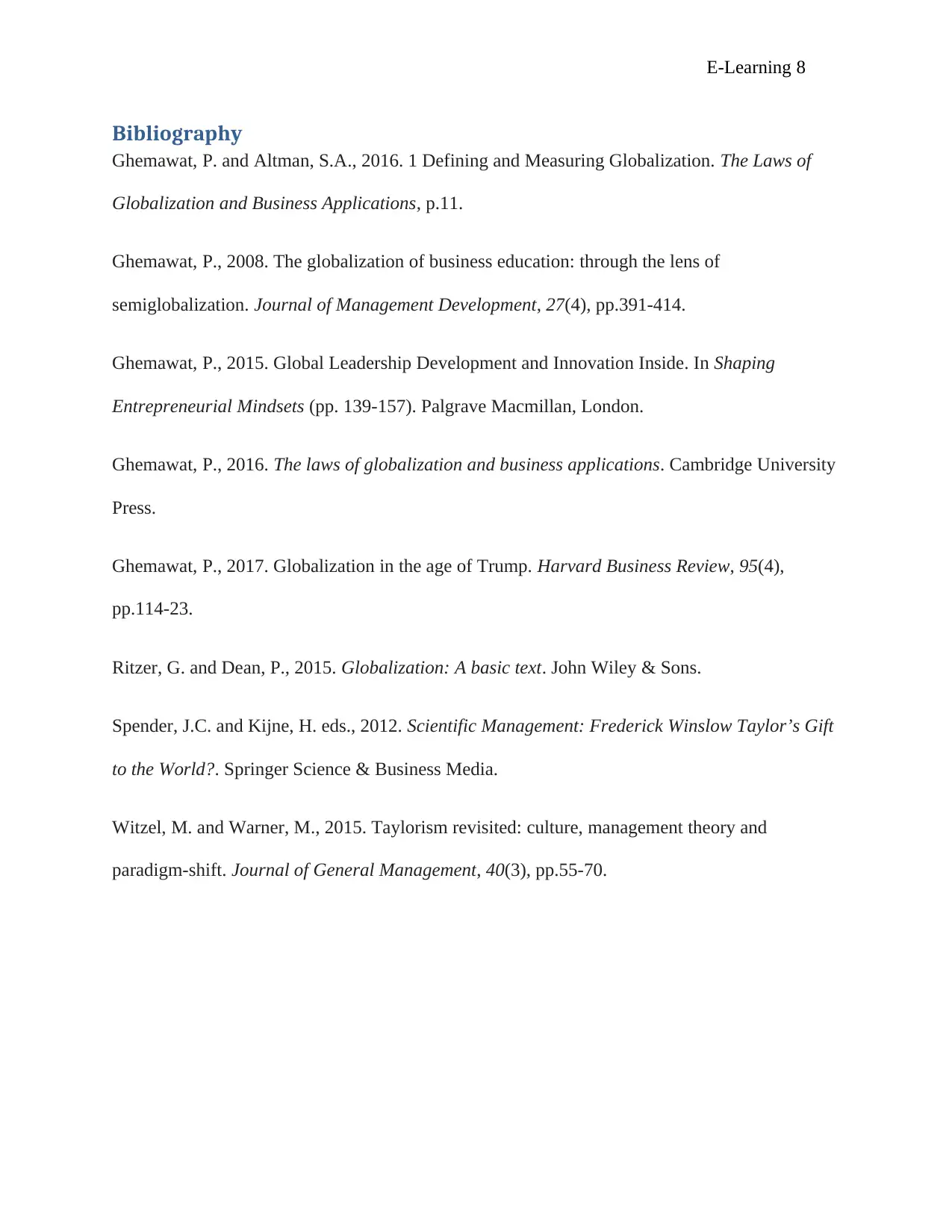
E-Learning 8
Bibliography
Ghemawat, P. and Altman, S.A., 2016. 1 Defining and Measuring Globalization. The Laws of
Globalization and Business Applications, p.11.
Ghemawat, P., 2008. The globalization of business education: through the lens of
semiglobalization. Journal of Management Development, 27(4), pp.391-414.
Ghemawat, P., 2015. Global Leadership Development and Innovation Inside. In Shaping
Entrepreneurial Mindsets (pp. 139-157). Palgrave Macmillan, London.
Ghemawat, P., 2016. The laws of globalization and business applications. Cambridge University
Press.
Ghemawat, P., 2017. Globalization in the age of Trump. Harvard Business Review, 95(4),
pp.114-23.
Ritzer, G. and Dean, P., 2015. Globalization: A basic text. John Wiley & Sons.
Spender, J.C. and Kijne, H. eds., 2012. Scientific Management: Frederick Winslow Taylor’s Gift
to the World?. Springer Science & Business Media.
Witzel, M. and Warner, M., 2015. Taylorism revisited: culture, management theory and
paradigm-shift. Journal of General Management, 40(3), pp.55-70.
Bibliography
Ghemawat, P. and Altman, S.A., 2016. 1 Defining and Measuring Globalization. The Laws of
Globalization and Business Applications, p.11.
Ghemawat, P., 2008. The globalization of business education: through the lens of
semiglobalization. Journal of Management Development, 27(4), pp.391-414.
Ghemawat, P., 2015. Global Leadership Development and Innovation Inside. In Shaping
Entrepreneurial Mindsets (pp. 139-157). Palgrave Macmillan, London.
Ghemawat, P., 2016. The laws of globalization and business applications. Cambridge University
Press.
Ghemawat, P., 2017. Globalization in the age of Trump. Harvard Business Review, 95(4),
pp.114-23.
Ritzer, G. and Dean, P., 2015. Globalization: A basic text. John Wiley & Sons.
Spender, J.C. and Kijne, H. eds., 2012. Scientific Management: Frederick Winslow Taylor’s Gift
to the World?. Springer Science & Business Media.
Witzel, M. and Warner, M., 2015. Taylorism revisited: culture, management theory and
paradigm-shift. Journal of General Management, 40(3), pp.55-70.
1 out of 8
Related Documents
Your All-in-One AI-Powered Toolkit for Academic Success.
+13062052269
info@desklib.com
Available 24*7 on WhatsApp / Email
![[object Object]](/_next/static/media/star-bottom.7253800d.svg)
Unlock your academic potential
Copyright © 2020–2025 A2Z Services. All Rights Reserved. Developed and managed by ZUCOL.





